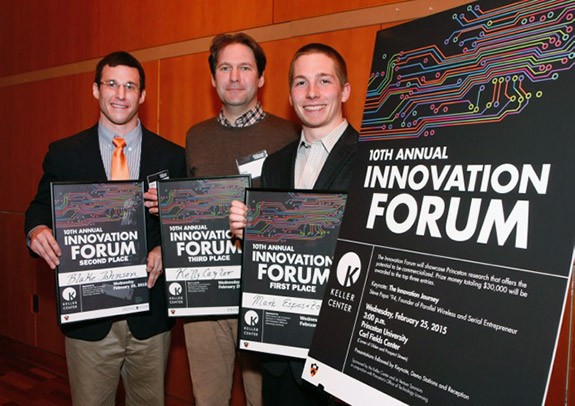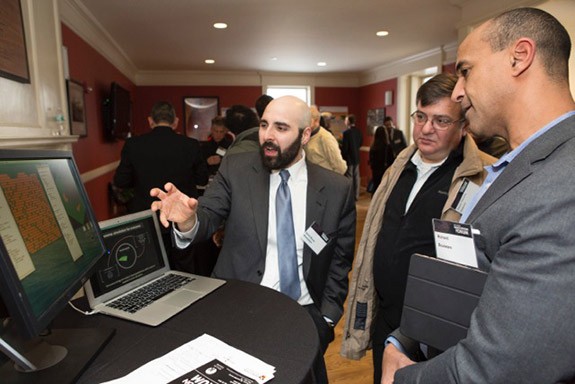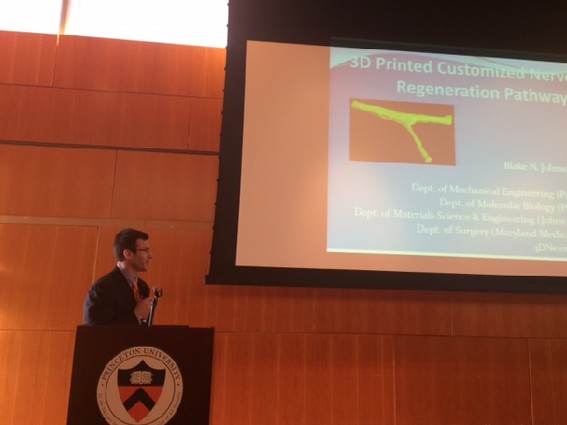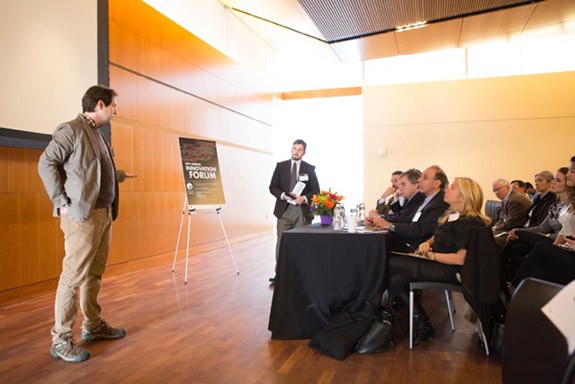New Approach to Cancer Therapy Takes Top Prize at Innovation Forum

Mark Esposito stood before a panel of judges at the Keller Center’s 10th annual Innovation Forum on Feb. 25 and made a bold statement — a leap forward in cancer treatment is close at hand.
“The problem is we’re treating the wrong disease,” said Esposito, a Princeton University graduate student in molecular biology.
Esposito took the top prize at the Innovation Forum, an event for University researchers to present potentially marketable discoveries, with his pitch for a method to stop the spread of cancer, called metastasis. Despite myriad combinations of chemotherapy, radiation and targeted biological agents — including 171 new drugs approved in recent decades — death rates for cancer have fallen only 20 percent since their peak 25 years ago, he said. These treatments attack cancer itself, but not metastasis. In his research, he found that blocking a single class of enzyme can dramatically lessen the spread of cancer cells and improve survival.
“Cancer is not just one dense mass. It spreads cancerous cells from the primary tumor to distant organs,” Esposito said, noting that metastasis is responsible for 90 percent of deaths.
Esposito found that molecular mechanisms that drive metastasis are far different from what allows an initial tumor to grow.
“We found if we were able to block one receptor, it dramatically lessens the spread of cancer cells,” he said. “By using that data, we thought instead of blocking just one, why can’t we block the entire cascade from happening? So by using a multipronged approach, we were able to show one single enzyme that’s central to this process, and by blocking that single enzyme [we] can improve survival.”
Following the enzyme discovery, Esposito developed a rapid screening technology to identify possible new drugs and is beginning to use that technology to hunt for drug candidates, which is where he anticipates his $15,000 prize will go.
As one of seven teams that pitched their research at the event, Esposito said he never anticipated winning.
“My heart was pounding the whole time,” he said. “I thought this would be very technology focused, so it’s actually really great to see the diversity in the presentations.”
Other research presented at the event ranged from sustainable furniture production to groundwater bioremediation. A member of each team delivered a three-minute pitch to a panel of judges consisting of investors and business leaders. After each presentation, the judges were allotted five minutes to ask questions on details such as potential risks and how they would use the funding. The event took place before a large audience of students, professors and industry professionals in the University’s Fields Center.

In the months leading up to the forum, the teams provided written drafts and recorded video of their pitches, which allowed the judges to provide feedback to the presenters.
Witnessing the improvements made by the presenters after critiquing their videos made an impression on forum judge Simon Hopkins, an enterprise software entrepreneur. “The quality of the presenters was very impressive,” he said.
As a local investor in several start-ups, Hopkins said it is important to integrate the academic and local community together, which is something the forum helps achieve.

Blake Johnson, a postdoctoral associate in mechanical and aerospace engineering, took home the second prize of $10,000 for his 3-D printed personalized nerve regeneration technology.
Johnson and Michael McAlpine, assistant professor of mechanical and aerospace engineering, developed an innovative technology that enables the first personalized approach for nerve regeneration.
Traumatic car accidents, battlefield incidents or diabetes can damage nerves, creating a gap between nerve segments, said Johnson.
The conventional technology to encourage nerves to regenerate and fill that gap is generic and is not multifunctional, leaving a lot of nerve injuries untreated or poorly treated, Johnson said.
By using 3-D manufacturing and patient-specific 3-D scanning and imaging, the Princeton researchers can create a scaffold customized according to the patient’s specific injury and to the patient’s geometry.
“We can mimic the natural nerve design that occurs in the body,” said Johnson. This “mass customization” of nerve regeneration is the focus of Johnson’s company, 3-D NeuroTech.

Taking the competition into the realm of agriculture, third-place winner Kelly Caylor, associate professor in civil and environmental engineering, explained how his environmental sensing platform, PulsePod, will help farmers.
The PulsePod device is combination of hardware and software that empowers land managers to make better decisions about their resources, he said. It provides in-field monitoring of crop health, microclimate, water and nutrients — information that is currently not easily available to farmers.
The device communicates securely with Internet-based computers that store data and perform analysis that helps farmers to optimize their resources, Caylor said. His team includes Adam Wolf, an associate research scholar in ecology and environmental biology, and Ben Siegfried, a Princeton alumnus and technical assistant in civil and environmental engineering.
The biggest challenge for Caylor was presenting a large amount of information within three minutes.
“I can barely say my full name under that time,” he joked. “But we’re happy with the result, and the funding will go into creating our software so we can see how users will interact with it.”
In addition to the presenters, keynote speaker Steve Papa, a Princeton alumnus and serial entrepreneur in the tech world, stressed the importance of perseverance and an understanding of industry experience.
“What turns ideas into innovation is ongoing interaction with real-world experiences,” said Papa. “Get exposed to industry, get exposed to real-world problems to work on. That’s the process that really produces innovation in the end.”

